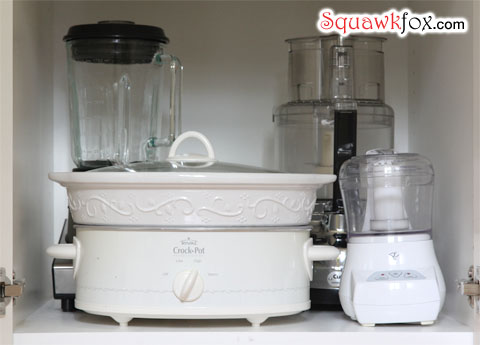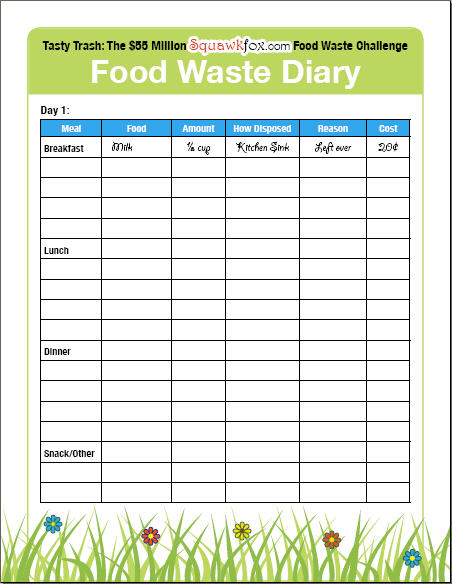This is a wonderful article on Pantry Organization is on the following website: http://www.squawkfox.com/2012/07/02/pantry/
Squawkfox also provides some printable helps which you can download from their site. I recommend you check them out. I will picture some of them at the end of the article.
1. Raid the pantry.

Canned goods in one pile, dried beans in another, spices in a stack, and baking goods far away from the kids.
Seeing your wares together on the floor can help you see what’s in stock and what’s been hanging out in your kitchen since the 80s.
2. Archive the artifacts.
Make note of all the expired items you’ve been storing in dire need of a compost bin or trash can. Check over your canned goods. If they’re expired, rusting, oozing, or bulging, toss them out!Scrutinize the non-expired stuff you’ll never eat and donate it to your local food bank. You’ll clear space for foods you enjoy, and perhaps make better use of your pantry when preparing meals in the future.
Also, be sure to open and inspect all bags, boxes, and canisters containing grain products. Many bugs, but mostly weevils, love breakfast cereals, crackers, cookies, cake or muffin mixes, pastas, and pancake powder. They also love big bags of warm flour. If you spy a fly or bug lurking in your Wheaties, be a champ and get rid of the bag.
Kill Bugs Cold: Weevils do not like the cold. If you’re unsure about the insect activity in your flour, an alternative to chucking (what might be perfectly good food) is to freeze questionable items for at least four days. The cold kills eggs, larvae, and weevils.
To prevent future infestation, find some space in your freezer and freeze them cold. Our family stored all bags of flour in the deep freeze full time. It was a smart way to prevent food waste, and the move saved my parents some needed sanity.
For those with small freezers who cannot afford the space, be a smart shopper and buy smaller portions of these products and use them regularly.
Your kitchen floor or countertop may look like a disaster. Don’t worry — things often get worse before they get better. Hugs.
3. Get scrubbing.
I lied. Things will get better in a minute. First, grab your vacuum and get down with the biggest de-crumbing you’ve endured since discovering that chowing on potato chips often sends flying potato pieces straight into your cleavage (if you’re a woman).Be sure to vacuum all cracks, crevices, cleavages, and spaces where grains of food could be hiding. If your pantry shelves are lined, remove the contact paper — you can reline later.
Grab a clean cloth (I use microfiber) and wipe down your pantry using a mixture of warm water and a few drops of dish detergent. Wipe it dry.
Reline your shelves with your preferred liner (IKEA sells some), or stock up on reusable non-adhesive shelf liner — just cut to size.
4. Do a pantry inventory.
With a clean pantry nearly ready to rumble, it’s time to take inventory.Why keep an inventory?
A pantry inventory details what you have stocked, shows what needs to be added to your grocery shopping list, and may inspire you to make meals with the ingredients you have on hand.Keeping a pantry inventory can help with meal planning since you’ll know what’s at home and what needs to be purchased. An up-to-date inventory can also make shopping less wasteful, saving you big money on your grocery budget. Who knows, maybe you can skip a supermarket trip!
What to record:
Item: What’s in your pantry? List canned goods, rice, dried beans, spices, cereals, snacks, quinoa, oatmeal, etc.
Quantity: How much is in stock? Do you have canned tomatoes to make stew this week? Quantity is an ongoing itemization of what you have in stock and what is about to run out. Make sure the kids update this column too!
Item Cost: You keep your grocery receipts, right? Go ahead and list the money spent on your food. It’s easiest to update when you’ve just done the groceries and restocked your pantry. This column can be a real eye-opener when you add up the total cost.
If you’re loving this level of organization, go ahead and check out this very popular post on refrigerator organization.
5 Steps to a Freshly Frugal Fridge
What’s inside your refrigerator? Prevent food waste and save money by getting your fridge organized and storing items in the smartest spots.
Lots of helpful tips, great graphics, and easy steps to keep your food fresher, for longer. Check out The Organized Fridge for the details.
When you’re done listing all your pantry wares, stick your inventory on the inside of a door. Update as needed.
5. Get in the zone. Reload.
Before restacking everything back on the same old shelf, consider the spots where everyday foods could be placed to make access easy. For example: Shoving your favorite breakfast cereal behind a wall of canned goods is a bonehead move, unless you’re hiding those tasty oats from a kiddlet or husband.Pick a pantry zone.
A few organizational ideas to get your pantry perfect:



Zone 4: Easy Meals. Store breakfast, lunch, or dinner foods on an eye-level shelf so rushed and hungry family members can find food fast.

Zone 5: Spillables. Place oils and vinegars on a spill-proof mat, and store non-refrigerated vegetables (potatoes, onions, etc.) in a cool dry place.

- Get grouped: Group similar stuff together by food type or meal. Dry goods on one shelf, canned on a second, spices stored in labeled jars, oils and vinegars on a spill-proof mat, non-refrigerated vegetables (potatoes, onions, etc.) in a cool space.
- Square containers: Skip the round ones — use square airtight storage containers to to keep dry ingredients fresh and maximize your space. Square containers can be easily stacked and waste less space than round models. Airtight containers are a great tool for preventing insects from infesting your wheat products.
- Expandable shelves: Expandable wire shelves double your space and help keep things stacked safely. Place a double wire shelf in the back of your cabinet and stack canned goods on it.
- Don’t get canned: Never stack canned goods on the highest shelves or on top of each other — they could topple and make a mess, damage something, or even injure you. Use a wire shelf as support to safely stack double-height.
- Shoe racks: Got an old IKEA hanging shoe rack hanging around your home? Hang it on the inside of the pantry door and store small items (potatoes, onions, spices) out of the way.
- Bin there: Bins and baskets do a great job of separating and organizing items on pantry shelves.





No comments:
Post a Comment